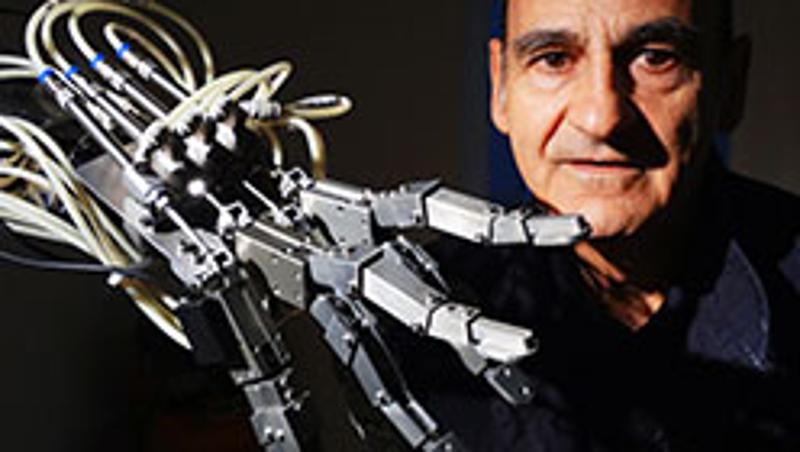
What will our bodies look like in the future? How does an extra and electronically connected ear fitted to your forearm sound? And what if it could give you ongoing connection to the internet and other technologies?
Seem far-fetched? Well this future is rapidly becoming a reality and the man who is pushing these physical and technological boundaries will be at QUT's Robotronica.
Robotronica is a free robotics and interactive technology extravaganza staged at QUT's Gardens Point campus in Brisbane on 23 August.
Robotronica creative director Jonathan Parsons said Stelarc, one of Australia's most significant living artists, would give festival attendees this glimpse into our possible future. He is one of three artists at Robotonica whose bodies are augmented with technology to improve performance and function.
"Stelarc is known internationally for using his body as the canvas upon which he experiments to push at the limitations of the human body," Mr Parsons said.
"For example, he has in the past fitted a mechanical human-like hand to his right arm.
That extra hand functioned just like any other hand and with electrical signals even incorporated a sense of touch.
"The Third Hand became the best-known performance object for Stelarc and typified a body of work that explored technology and prosthetics not as a replacement but as an addition to the body.
"Stelarc shows us a future where prostheses could be used to augment the body, giving it additional functionality, rather than our current view of prosthetics as making up for limbs that a body lacks."
Mr Parsons said Stelarc's newest experimentation involved the use of the performance artist's own stem cells to grow an ear under the skin on his forearm. Built around a scaffold, the ear will ultimately be a combination of biology and technology that is a one-of-its-kind in the world.
"The ear will soon be lifted off Stelarc's arm to make it truly three dimensional and his own stem cells will be used to grow a lobe for the ear.
"Then, a miniature microphone will be implanted within Stelarc's Ear on Arm to provide wireless connection to the Internet and enable people in other places to listen to what Stelarc's third ear is hearing, for example a concert.
"The Ear on Arm project suggests changes to the human anatomy that question the concept of our bodies being bounded by our skin."
Stelarc, who is a Professor at Curtin University in Western Australia and an Honorary Professor of Art and Robotics at Carnegie Mellon University in the US, will give a keynote talk at Robotronica and will engage with the public on the day.
Mr Parsons said certified cyborg, Neil Harbisson, would also attend Robotronica.
Born in Britain and raised in Spain, Neil has a form of extreme colour blindness; he can see only in greys.
"In 2004 he collaborated with Adam Montandon to create a cybernetic system permanently implanted in his head which allows him to perceive colours as sounds - the busier the colour pattern, the more notes that play in his head.
"Neil will discuss this technology in a public talk at Robotronica. He'll also speak about co-founding the Cyborg Foundation, established to defend cyborg rights, help others to access cyborg technology and promote cyborgism as an art movement."
Th world's fastest drummer Jason Barnes will also attend Robotronica.
Hailing from Georgia Tech in Atlanta, Barnes' cyborg drumming arm allows him to play with greater speed and complexity than an ordinary human.
He will perform with the Shimon Robot & Friends at Robotronica where the public will be able to see his amazing prosthetic drumming arm in action.
The robotic drumming prosthesis has two drumsticks that are powered by motors. While the first stick is controlled both physically by the musician's arms and electronically using electromyography (EMG) muscle sensors the other stick "listens" to the music being played and improvises.
Mr Parsons said Barnes lost his arm after being electrocuted while working on a roof in 2012.
"A drummer, Barnes built a makeshift drumming hand out of a wrist brace and a spring, enrolled at the Atlanta Institute of Music and Media where drum teacher Gil Weinberg, the founding director of Georgia Tech's Centre for Music Technology built Barnes an arm that would not just restore its functionality but allow him to play better than before."
Media contact: Rose Trapnell, QUT media team leader, 07 3138 2361 or 0407 585 901 rose.trapnell@qut.edu.au


